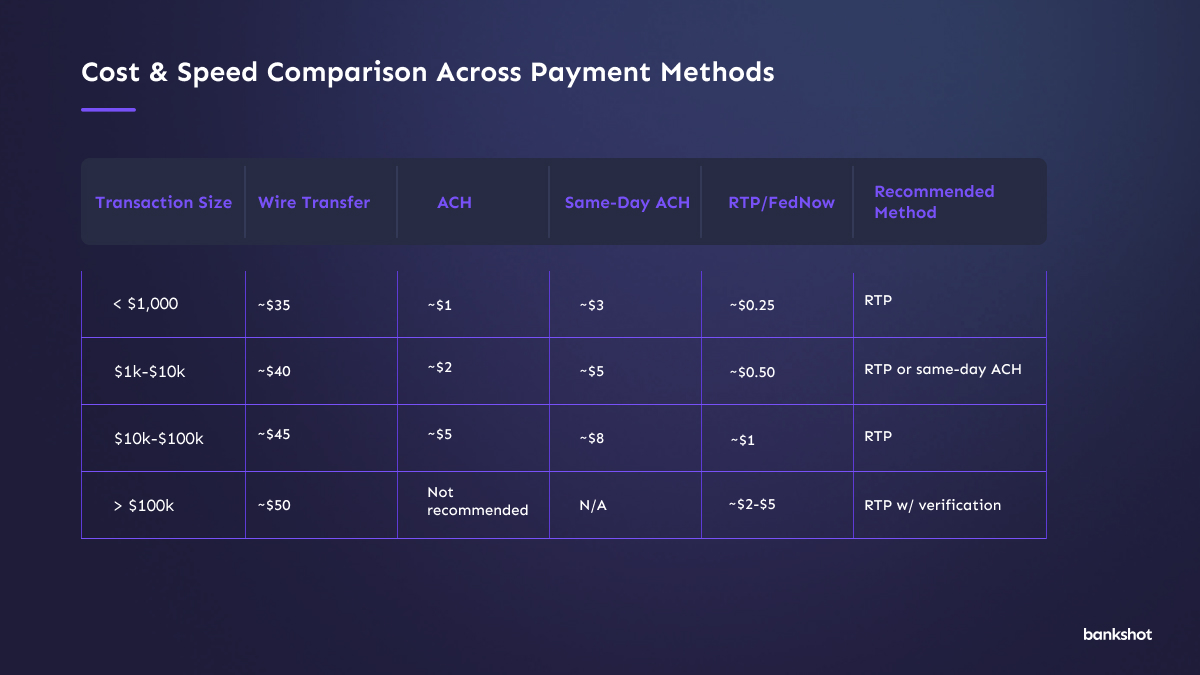
Still chasing checks? It’s time to upgrade. Learn how today’s real estate payment solutions cut delays and close deals faster.

Remember when closing a deal meant chasing checks?
Yeah, us too. Thankfully, real estate payment solutions have come a long way—if you're using the right one.
The problem is, while most industries digitized their payment systems years ago, real estate has been stuck in a time warp. We're talking about an industry where billion-dollar transactions still happen via methods that were outdated when fax machines were cool.
The stakes?
According to the FBI, real estate professionals and consumers reported 9,521 wire fraud claims totaling $145 million in losses in 2023 alone.
That's not a typo.
$145 million vanished because we've been relying on payment methods designed for a pre-Internet world. But here's the thing: The transformation is finally happening, and it's happening fast. From instant payments to blockchain-enabled transfers, the landscape is shifting beneath our feet. Whether you're a veteran broker or a first-time buyer, understanding these changes is the key to protecting your transactions (and your peace of mind).
Let's take a trip down memory lane. Not too long ago, real estate transactions moved at the speed of, well, snail mail.
.jpg)
Physical checks dominated the landscape, requiring in-person meetings, manual deposits, and agonizing wait times. Wire transfers emerged as the “modern” solution, but they brought their own headaches:
The Consumer Financial Protection Bureau documented a 1,100% increase in wire fraud attempts between 2015 and 2017, exposing how vulnerable traditional payment methods had become.
Fraudsters exploited gaps in legacy systems, while professionals were left trying to win a Formula 1 race in a station wagon.
By 2018, digital solutions started gaining traction, pushed by regulatory pressure and consumer demand. The Federal Reserve’s launch of FedNow in 2023 marked a turning point, offering instant settlement capabilities that finally brought real estate into the 21st century.
Today, we’re seeing:
Together, they’ve transformed transactions that once took days into those that now clear in seconds.
Commercial real estate is particularly benefiting from innovations like virtual card programs and blockchain-enabled payment rails. These technologies move money faster and create immutable audit trails, automate reconciliation, and embed fraud detection directly into the payment flow.
The result? Transactions that are simultaneously faster, cheaper, and more secure than anything we've seen before. Specialized providers, including Bank Shot, focus on building these modern payment infrastructures specifically for real estate's unique requirements, recognizing that one-size-fits-all solutions don't cut it when you're moving six-figure sums.
A modern real estate payment solution isn’t just fast. It’s an end-to-end ecosystem that addresses every pain point in the transaction lifecycle, from earnest money deposits to final disbursements.
First, there's the infrastructure layer.
Modern solutions leverage multiple payment rails—ACH, real-time payments (RTP), FedNow, and yes, even traditional wires when necessary—to provide flexibility based on timing, cost, and risk tolerance. They integrate directly with title company software, MLS systems, and accounting platforms to eliminate manual data entry and the errors that come with it.
The American Land Title Association's Good Funds framework explicitly addresses how these new payment methods satisfy good funds requirements, providing legal clarity that was previously murky.
Second, there's the security layer.
Modern systems employ multi-factor authentication, biometric verification, and behavioral analytics to detect anomalies before they become disasters. They maintain encrypted communication channels and provide real-time transaction monitoring that flags suspicious activity instantly.
The difference between legacy and modern systems isn't just technological—it's philosophical. Old systems assumed transactions were legitimate unless proven otherwise. New systems verify everything, trust nothing, and authenticate constantly.
.jpg)
Here's an uncomfortable truth: first-time homebuyers are three times more likely to fall victim to wire fraud than experienced buyers. Why? Because they don't know what “normal” looks like. When you're navigating your first transaction, everything feels chaotic and urgent, which is exactly what fraudsters count on.
.jpg)
By the time the fraud is discovered, the money is gone. Wire transfers are irrevocable. The emotional and financial devastation is compounded by the realization that prevention was entirely possible if only the warning signs had been recognized. But how do you recognize warning signs when you don't know what questions to ask? That's where systematic verification protocols become non-negotiable.
Digital transformation in real estate has created new vulnerabilities, but it's also enabled better defenses. Understanding the tactics helps you spot them before they succeed. Email spoofing uses domains that are nearly identical to legitimate ones—think "bankofamerica.com" vs. “bankofamericca.com” (notice the extra 'c').
Phone number spoofing displays legitimate caller IDs while routing through fraudulent systems. Timing manipulation creates artificial urgency to bypass normal verification procedures.
The most sophisticated attacks involve social engineering that exploits emotional triggers. "If you don't wire by 3 PM, you'll lose the property" is a favorite, as is "The seller is threatening to back out if payment doesn't arrive today."
These tactics work because real estate transactions are inherently stressful and time-sensitive. That’s why it’s so important to slow down. Real closings don't happen on surprise timelines. Real title companies don't change wire instructions at the last minute. Real professionals encourage verification; they don’t discourage it.
Verification isn't complicated, but it must be systematic. Here's the protocol that stops fraud cold:
At the beginning of your transaction, during the initial meeting or contract signing, explicitly discuss how payment instructions will be communicated. Get direct phone numbers—not email addresses—for key parties. Establish a verbal verification process that everyone agrees to follow, no exceptions. Document these agreed-upon procedures in writing and share them with all parties.
This is the golden rule. Treat every email containing payment instructions as potentially fraudulent until proven otherwise. If you receive wire instructions via email, do not use any contact information from that email to verify.
Instead, use the phone numbers you established in Step 1—numbers you obtained independently, not from any electronic communication.
Call the title company, escrow officer, or appropriate party using the pre-established number. Ask them to verbally confirm every detail: bank name, routing number, account number, account holder name, etc.
Do not accept "it's all in the email" as an answer. Have them read each digit individually. Compare what they say to what the email shows. Any discrepancy—even one digit—requires investigation before proceeding.
Legitimate payment instructions rarely change. If you receive "updated" instructions, especially close to closing, your fraud alarm should blare.
Ask pointed questions: Why are the instructions changing? Who authorized the change? Can you visit the office in person to verify? Fraudsters rely on victims being too embarrassed to ask these questions. Don't be that victim.
Modern payment infrastructure providers embed verification into their systems, requiring multi-factor authentication and providing confirmation at every step. These systems create digital trails that make fraud significantly harder and provide recourse if something does go wrong. The small cost of using these platforms pales in comparison to the protection they provide.
Before sending six figures, send $100. Confirm receipt with a phone call. This simple step catches routing errors and fraud attempts before they become catastrophic. Yes, it adds a day to the process. That's infinitely better than losing your entire down payment.
Theory is great, but nothing beats seeing the patterns in action. Let's walk through actual fraud attempts (sanitized for privacy) that were either caught or tragically successful, so you know what to watch for.
.jpg)
Recent regulatory developments are adding new layers of transparency to real estate transactions. The Treasury Department's Anti-Money Laundering Regulations will have changes taking effect in March 2026, which will require detailed reporting on high-risk residential real estate transfers. While this creates compliance obligations, it also makes fraudulent transactions significantly harder to execute and easier to trace. Modern payment platforms are already building these reporting requirements into their systems, turning regulatory compliance from a burden into a fraud deterrent.
So you've verified everything. The instructions are legitimate. You're ready to send money. Now what? The execution phase has its own best practices that separate secure transactions from vulnerable ones.
Commercial real estate payment infrastructure demonstrates the gold standard: dedicated treasury services with segregated accounts, automated reconciliation, and real-time reporting. While residential transactions may not need this level of sophistication, the principles apply universally.

The transformation isn't slowing down—it's actually accelerating. Several emerging trends will fundamentally reshape real estate payments over the next few years, and understanding them now positions you ahead of the curve instead of scrambling to catch up.
Fraud detection is no longer optional. Machine learning now flags suspicious transactions in real time, long before humans notice. It’s fast, efficient, and getting smarter with every attempt it blocks.
Bank Shot already builds this intelligence into its verification and monitoring, so users stay a step ahead.
Instant settlement used to be a fantasy in real estate. Not anymore. Platforms like FedNow and RTP make it possible to move money in seconds—without the risk of wires.
Bank Shot is built to support this shift, ensuring transactions clear securely and instantly.
Regulators are tightening reporting and verification requirements. The good news? Modern systems automate most of it.
Bank Shot’s infrastructure is designed to meet new standards by default—so your transactions stay compliant without extra effort.
Soon, payments will just happen—seamlessly integrated into contract and transaction software.
Bank Shot is already moving in that direction, building tools that eliminate manual entry, cut fraud risk, and simplify the closing process for everyone involved.
While general payment processors continue serving broad markets, specialized providers are building purpose-built solutions that understand real estate's unique requirements.
Digital transformation in real estate payments isn't about adapting consumer payment apps to commercial use—it's about building from scratch with real estate workflows, compliance requirements, and risk profiles as the foundation. The providers who get this distinction are pulling ahead, offering integrated solutions that handle everything from earnest money to final disbursement with security features specifically designed for real estate's threat landscape.
The winners in this space won't be the cheapest or the flashiest. They'll be the ones who understand that modern real estate payment solutions need to build trust, maintain compliance, and protect what's often the largest financial transaction of someone's life. That requires infrastructure purpose-built for the task, not retrofitted from unrelated industries.
We've covered a lot of ground—from the dark ages of physical checks to the AI-powered fraud detection of tomorrow. But knowledge without action is just trivia. So what do you actually do with all this information?
Here’s your checklist:
✅ Audit your payment process—find gaps and weak points
✅ Implement verification protocols immediately
✅ Use real estate-specific payment platforms (like Bank Shot)
✅ Stay informed on new regulations and tech
The evolution from checks to clicks isn’t just about convenience; it’s about trust, compliance, and protection.
Experience the future of earnest money management and join the growing number of satisfied clients who have already embraced Bank Shot's innovative solutions.
Discover more insights and tips in these related articles.

